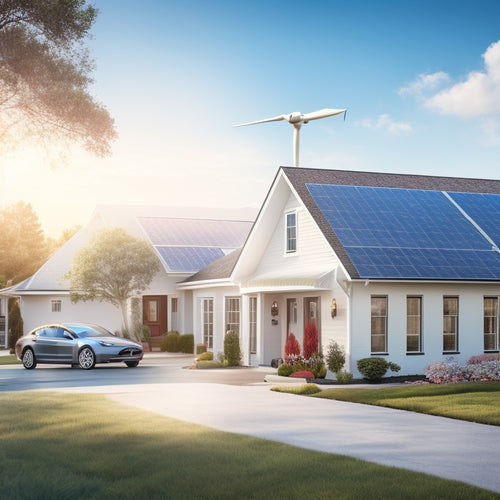Residential Energy Storage System Cost Breakdown
Share
When investing in a residential energy storage system, you'll need to take into account a multifaceted cost breakdown that includes the price of solar batteries, inverters, converters, installation, monitoring, and maintenance, as well as utility company charges, local permitting fees, and warranty expenses. A typical lithium-ion battery costs between $7,000 to $10,000, while advanced batteries with monitoring can exceed $20,000. Inverter and converter expenses add to the total, alongside installation and labor fees, which vary based on complexity, location, and installer expertise. As you dig deeper, you'll uncover a complex web of costs that can total tens to hundreds of thousands of dollars.
Key Takeaways
• Solar battery costs vary widely, ranging from $7,000 to $20,000 or more, depending on type, quality, and capacity.
• Inverter and converter expenses are critical, as high-efficiency components minimize energy losses and ensure reliable energy flow.
• Installation and labor fees vary greatly, depending on location, installer expertise, and system complexity, with electrician rates ranging from $50 to $250 per hour.
• System monitoring and maintenance are essential for optimizing energy efficiency, detecting potential failures, and ensuring cybersecurity, with costs factored into the overall system expense.
• Utility company charges, local permitting costs, and battery type and capacity must be considered in the overall cost breakdown, with varying fees and regulations affecting the final price.
Solar Battery Costs and Pricing
When sizing a residential energy storage system, you'll likely find that solar battery costs and pricing vary widely depending on the type, quality, and brand of the battery, as well as the capacity and depth of discharge required for your specific application. Don't be surprised if you're quoted prices ranging from a few thousand to tens of thousands of dollars.
The good news is that energy efficiency is a key driver of these costs, so opting for a high-efficiency battery can lead to significant long-term savings.
To give you a better idea, a typical lithium-ion battery with a capacity of 10 kWh might cost around $7,000 to $10,000. However, if you're looking for a high-end option with advanced features like monitoring and control systems, be prepared to shell out upwards of $20,000.
On the bright side, many governments offer green incentives, such as tax credits or rebates, to encourage the adoption of energy storage systems. These incentives can help offset the upfront costs and make your investment more financially viable.
Inverter and Converter Expenses
You'll need to factor in the cost of inverters and converters, which can add up to several thousand dollars, depending on the type and quality of the components, as well as the system's power rating and grid connection requirements. These components are important to guarantee your energy storage system runs smoothly and efficiently.
Here are some key considerations to keep in mind:
-
Inverter efficiency: Look for inverters with high efficiency ratings to minimize energy losses and maximize your system's overall performance.
-
Converter reliability: A dependable converter ensures a stable flow of energy and reduces the risk of system failures or downtime.
-
Compatibility and integration: Make sure your inverter and converter are compatible with your energy storage system and can integrate seamlessly with other components.
When selecting inverters and converters, it's crucial to prioritize quality and reliability to ensure excellent system performance and minimize potential downtime.
Installation and Labor Fees
Your residential energy storage system's installation and labor fees can add up quickly, depending on the complexity of the installation, the location, and the installer's expertise.
For instance, if you live in a remote area, you might need to pay more for the installer's travel time and accommodations. On the other hand, if you're in an urban area, labor costs might be lower due to the availability of skilled electricians.
Speaking of electricians, their rates can vary greatly depending on their experience and qualifications. On average, electrician rates range from $50 to $150 per hour, with some experts charging upwards of $250 per hour.
Additionally, labor laws in your state or region might impact the total cost. For example, some states require a certain number of apprentices to be on site, which can increase labor costs.
To get an accurate estimate, it's important to get quotes from multiple licensed electricians who've experience with energy storage system installations. Be sure to ask about their experience, certifications, and the specific services included in their quote.
System Monitoring and Maintenance
As you assess the cost of a residential energy storage system, you'll need to take into account the expenses associated with system monitoring and maintenance.
These costs include the tools and software necessary for tracking system performance, remotely monitoring the system's status, and utilizing predictive maintenance tools to identify potential issues before they occur.
System Performance Tracking
The system performance tracking component of a residential energy storage system involves real-time monitoring of key performance indicators, such as state of charge, depth of discharge, and round-trip efficiency, to guarantee efficient system operation and identify potential maintenance needs. This is important because you want to make sure your system is running smoothly and efficiently, without any hiccups. Think of it like keeping an eye on your system's essential signs - you want to catch any potential issues before they become major problems.
Here are some key benefits of system performance tracking:
-
Data Analytics: With real-time monitoring, you can analyze your system's performance data to identify areas for improvement, optimizing your energy efficiency and reducing costs.
-
Energy Efficiency: By tracking your system's performance, you can ensure that it's operating at peak efficiency, reducing energy waste and minimizing your carbon footprint.
-
Proactive Maintenance: Real-time monitoring allows you to catch potential issues before they become major problems, reducing downtime and extending the lifespan of your system.
Remote Monitoring Capabilities
Through remote monitoring capabilities, you can access real-time system performance data and receive alerts and notifications, enabling swift issue resolution and minimizing system downtime. This means you'll be the first to know when something's amiss, and you can take action before it becomes a major problem. With remote monitoring, you can:
| Feature | Benefit |
|---|---|
| Real-time data analytics | Identify trends and optimize system performance |
| Automated alerts and notifications | Stay on top of system issues before they escalate |
| Cybersecurity measures | Protect your system from unauthorized access |
| Customizable dashboards | View your system's performance in a way that makes sense to you |
Predictive Maintenance Tools
You can leverage predictive maintenance tools to detect potential system failures before they occur, ensuring proactive maintenance and minimizing costly downtime. By integrating AI-powered algorithms and machine learning techniques, these tools can analyze real-time data from your energy storage system, identifying potential issues before they become major problems. This proactive approach saves you from the headache of unexpected breakdowns, reducing maintenance costs and extending the lifespan of your system.
Here are some key benefits of predictive maintenance tools:
-
Digital Twin: Create a virtual replica of your energy storage system, allowing for real-time monitoring and simulation-based analysis to predict potential failures.
-
AI-driven diagnostics: Leverage machine learning algorithms to identify patterns and anomalies in system data, enabling early detection of potential issues.
-
Real-time alerts: Receive timely notifications when potential issues are detected, enabling swift action to prevent system downtime.
Grid Connection and Permit Costs
When installing a residential energy storage system, you'll need to take into account the costs associated with connecting to the grid and obtaining necessary permits. These costs typically include grid connection fees, utility company charges, and local permitting costs, which can vary depending on your location and the specific requirements of your utility company.
Grid Connection Fees
Grid connection fees, which encompass the costs of connecting your residential energy storage system to the grid, can add up to a significant portion of your overall system expenditure, with average permitting costs ranging from $500 to $2,000.
As you navigate the complex world of energy storage, it's crucial to understand the fees associated with grid connection.
Here are some key factors to keep in mind:
-
Utility Tariffs: Be prepared to pay fees based on your system's capacity and the amount of energy you're feeding back into the grid. These tariffs can vary depending on your location and utility company.
-
Connection Incentives: You might be eligible for incentives or rebates from your utility company or government for connecting your energy storage system to the grid. Do your research to maximize these benefits!
-
Permitting and Inspection Fees: Don't forget to factor in the costs of obtaining necessary permits and undergoing inspections to make sure your system meets safety and regulatory standards.
Utility Company Charges
Your utility company assesses charges for connecting your residential energy storage system to the grid, which include the costs of grid connection and permits, adding to the overall expense. These charges can vary depending on your location, utility company, and type of grid connection.
You'll need to take into account the time of use rates, which determine how much you pay for electricity during peak and off-peak hours. Your utility company may have different rate structures, such as tiered rates, flat rates, or demand charges, which affect your overall cost.
For instance, if you live in an area with high peak-hour demand, your utility company may charge you more during those hours. However, if you have a time-of-use rate plan, you can optimize your energy storage system to charge during off-peak hours and discharge during peak hours, reducing your energy costs.
Understanding your utility company's rate structures and time-of-use rates is essential for minimizing your energy expenses and maximizing your energy storage system's benefits. By factoring these charges into your overall cost breakdown, you can make informed decisions about your residential energy storage system.
Local Permitting Costs
Obtaining necessary permits and connecting your residential energy storage system to the grid involves a series of local permitting costs. These include fees for plan reviews, inspections, and utility company approvals, which can vary greatly depending on your location and system size. You'll need to navigate the complex web of local regulations, including zoning regulations and building codes, to make sure your system complies with all the necessary standards.
Here are some key costs to take into account:
-
Plan review fees: These fees cover the cost of reviewing your system design and confirming it meets local building codes and zoning regulations.
-
Inspection fees: You'll need to pay for inspections to verify that your system is installed correctly and meets safety standards.
-
Utility company approval fees: Your utility company may charge fees for approving your system's connection to the grid.
Battery Type and Capacity Impact
When choosing a residential energy storage system, you'll find that the battery type and capacity have a considerable impact on the overall cost, with different chemistries and sizes yielding vastly disparate price points. The type of battery you choose will greatly influence the final bill, so understanding the trade-offs is crucial.
Lithium-ion batteries, for instance, boast high energy density, making them a popular choice for residential energy storage. However, their higher cost per kilowatt-hour (kWh) compared to lead-acid batteries might put a dent in your wallet. On the other hand, lead-acid batteries are more affordable upfront but may require more frequent replacements due to their shorter cycle life. This highlights the importance of considering the total cost of ownership, including maintenance and replacement costs, when making your decision.
The capacity of your battery bank also plays a significant role in determining the overall cost. A larger capacity system will generally cost more upfront, but it may provide more extended backup power and greater energy independence.
As you weigh your options, keep in mind that finding the perfect balance between capacity and cost will depend on your specific energy needs and budget constraints.
Depth of Discharge and Cycles
When evaluating the total cost of your residential energy storage system, it's important to consider the depth of discharge (DOD) and cycle life of your battery, as these factors greatly influence its lifespan and performance.
You see, the DOD refers to the percentage of a battery's capacity that's used during each discharge cycle. A higher DOD means you're using more of your battery's capacity, which can reduce its overall lifespan. On the other hand, a lower DOD can increase the cycle life of your battery.
Here are some key things to keep in mind:
-
Cycle life: The number of charge and discharge cycles your battery can handle before its capacity starts to degrade. A higher cycle life means your battery will last longer.
-
Discharge rates: The rate at which your battery is discharged can affect its overall lifespan. Faster discharge rates can reduce the cycle life of your battery.
-
Ideal DOD: Finding the sweet spot for your DOD can help you maximize your battery's lifespan and performance. Aim for an ideal DOD that balances your energy needs with your battery's lifespan.
Warranty and Support Expenses
As you navigate the cost breakdown of your residential energy storage system, you'll also need to factor in the warranty and support expenses that come with your battery's lifecycle management. Think of it as insurance for your battery's health - you want to guarantee it's running smoothly and efficiently for years to come.
Warranty and support expenses can vary depending on the manufacturer and the type of service agreement you opt for. Typically, a standard warranty will cover your battery for a certain number of years or cycles, whichever comes first. But if you want extended coverage, you'll need to take into account the additional cost. This could be a one-time payment or an ongoing subscription-based model.
Service agreements can also provide peace of mind, offering priority support and maintenance schedules to prevent unexpected downtime.
When calculating your warranty and support expenses, be sure to take into account the cost of extended coverage and service agreements. It may seem like an added expense, but trust us, it's worth it in the long run.
Total System Cost and ROI
You'll need to calculate the total system cost by adding up the expenses of the energy storage system, including the battery, inverter, installation, and warranty/support costs, to determine the overall investment required for your residential energy storage system.
Getting a clear picture of your total system cost will help you make informed decisions about your energy storage project.
Here are a few key considerations to keep in mind:
-
System Sizing: Make sure you're sizing your system correctly to meet your energy needs. A system that's too small won't provide enough power, while one that's too large will be a waste of money.
-
Financial Projections: Crunch the numbers to determine your return on investment (ROI). How long will it take for the system to pay for itself through energy savings?
-
Hidden Costs: Don't forget to factor in any additional expenses, such as maintenance and monitoring costs, that mightn't be immediately apparent.
Frequently Asked Questions
Can Residential Energy Storage Systems Be Used for Backup Power?
You can definitely use residential energy storage systems for backup power, ensuring power security during grid outages, so you won't be stuck in the dark, literally, when the grid fails.
Are Energy Storage Systems Compatible With All Solar Panel Brands?
You're wondering if your energy storage system will play nice with any solar panel brand, right? Good news: most systems are designed for seamless brand compatibility, ensuring smooth system integration and a hassle-free backup power experience.
Do Energy Storage Systems Require Regular Software Updates?
You'll be relieved to know that, yes, energy storage systems do require regular software updates to stay ahead of cybersecurity threats, and firmware updates guarantee your system remains secure and optimized for peak performance.
Can I Add More Batteries to My System in the Future?
When you invest in a modular energy storage system, you'll appreciate the scalability concerns disappearing, as you can easily add more batteries in the future, thanks to its futureproofing benefits, allowing for seamless battery upgrades and system flexibility that's music to your wallet's ears!
Are Energy Storage Systems Eligible for Federal Tax Credits?
You're eligible for federal tax credits up to 26% of your energy storage system's cost, thanks to the Solar Investment Tax Credit (ITC). Note that Tax Credit Limits apply, so be sure to check Incentive Programs for updates!
Related Posts
-

Why Homeowners Are Embracing DIY Energy Independence
By taking control of your energy needs, you're breaking free from the uncertainty of utility bills and embracing a se...
-

What Role Do Unicycles Play in Urban Transport?
As you navigate through congested city streets, unicycles emerge as a viable solution, slashing carbon emissions by u...
-

Why Cities Need Smart Charging Infrastructure Now
You're about to experience a tidal wave of electric vehicles hitting your city's streets, and it's essential you're p...


